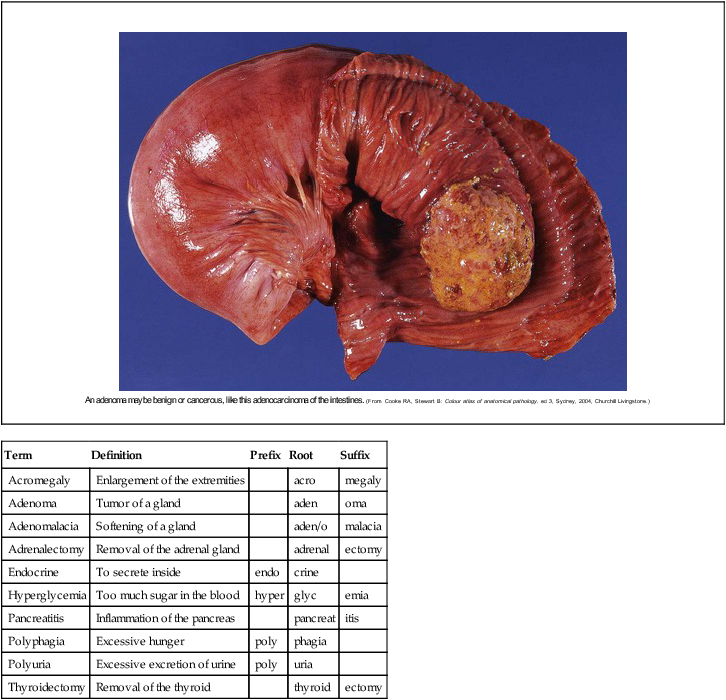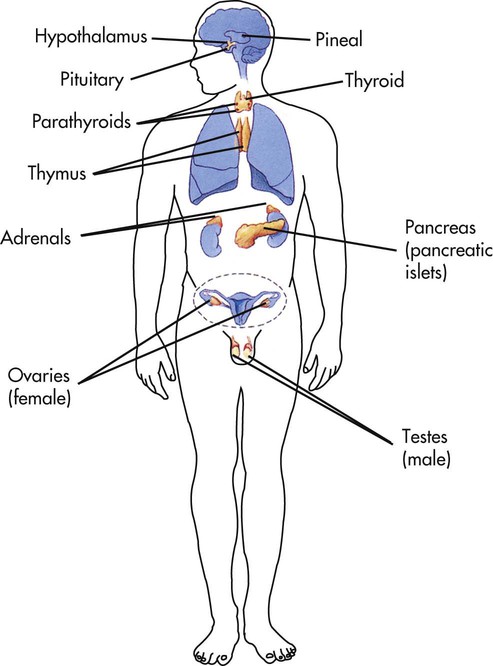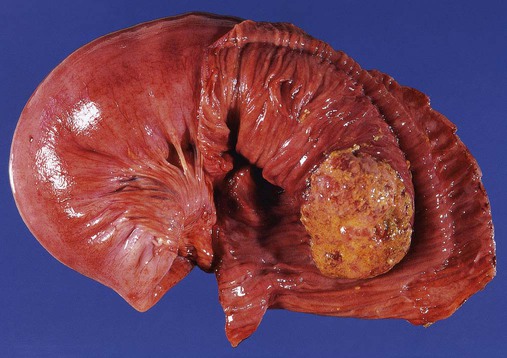Chapter 18 *A transition syllable or vowel may be added to or deleted from the word parts to make the combining form. The primary function of the endocrine system is to produce hormones that monitor and coordinate body activities (Fig. 18-1). Hormones are chemical messengers secreted by the endocrine glands. Each type of hormone moves through the blood to its own target cells, which react specifically to it. The endocrine glands secrete hormones directly into the bloodstream. Hormones may be proteins, glycoproteins, polypeptides, amino-acid derivatives, or lipids. Hormones may also be divided into categories on the basis of their function: Hormones direct many body processes, including growth, metabolism, and reproductive functions (Table 18-1). Hormones regulate the body’s reaction to stress and maintain the internal environment (homeostasis). The importance of hormones in the body can be demonstrated by the numerous and diverse disorders that occur when the amount of hormone produced is either too great (hypersecretion) or too little (hyposecretion). The quantity of hormones in the blood is monitored through a negative feedback mechanism, which stimulates more secretion when needed (Fig. 18-2). Additionally, the autonomic nervous system controls and stimulates the secretion of the hormones of the adrenal gland. TABLE 18-1 Endocrine Glands and Hormones* *Most of the endocrine glands secrete more than one hormone with functions not listed here. The pituitary gland (hypophysis) is sometimes called the “master” gland because the hormones that it produces regulate the secretion of other glands (Fig. 18-3). It is located at the base of the brain and is divided into two parts: the anterior and posterior. The anterior pituitary (adenohypophysis) gland produces seven hormones:
Endocrine System
 Define 10 terms relating to the endocrine system.
Define 10 terms relating to the endocrine system.
 Describe the function of the endocrine system.
Describe the function of the endocrine system.
 Identify at least nine endocrine system structures.
Identify at least nine endocrine system structures.
 Identify at least one hormone produced by each of the 10 endocrine glands.
Identify at least one hormone produced by each of the 10 endocrine glands.
 Describe at least three methods used to assess the function of the endocrine system.
Describe at least three methods used to assess the function of the endocrine system.
Term
Definition
Prefix
Root
Suffix
Acromegaly
Enlargement of the extremities
acro
megaly
Adenoma
Tumor of a gland
aden
oma
Adenomalacia
Softening of a gland
aden/o
malacia
Adrenalectomy
Removal of the adrenal gland
adrenal
ectomy
Endocrine
To secrete inside
endo
crine
Hyperglycemia
Too much sugar in the blood
hyper
glyc
emia
Pancreatitis
Inflammation of the pancreas
pancreat
itis
Polyphagia
Excessive hunger
poly
phagia
Polyuria
Excessive excretion of urine
poly
uria
Thyroidectomy
Removal of the thyroid
thyroid
ectomy

Structure and Function of the Endocrine System

 Nonsteroid hormones are proteins that work as “first-messengers.” They act on cells of the target organ to cause them to produce or release a second messenger molecule.
Nonsteroid hormones are proteins that work as “first-messengers.” They act on cells of the target organ to cause them to produce or release a second messenger molecule.
 Tropic hormones target other endocrine structures to increase their growth and secretions.
Tropic hormones target other endocrine structures to increase their growth and secretions.
 Sex hormones influence reproductive changes.
Sex hormones influence reproductive changes.
 Anabolic hormones stimulate the process of building tissues.
Anabolic hormones stimulate the process of building tissues.
Gland
Hormone
Function
Pituitary
Somatotropin (or growth hormone [GH])
Promotes tissue growth and development
Pineal
Melatonin
Supports the biological clock
Thyroid
Thyroxine (TH)
Regulates the metabolic rate
Parathyroid
Parathyroid hormone (PTH)
Regulates calcium and phosphates in the bloodstream and bones
Thymus
Thymosin
Stimulates development of T cells
Adrenal
Epinephrine
Regulates autonomic nervous system response
Pancreatic islets
Insulin
Regulates blood sugar
Ovaries
Estrogen
Regulates female sexual characteristics
Testes
Testosterone
Regulates male sexual characteristics
Glands and their Hormones
Hypothalamus
Pituitary
 Thyroid-stimulating hormone (TSH) stimulates the growth and secretion of the thyroid gland.
Thyroid-stimulating hormone (TSH) stimulates the growth and secretion of the thyroid gland.
 Adrenocorticotrophic hormone (ACTH) stimulates the growth and secretion of the adrenal cortex.
Adrenocorticotrophic hormone (ACTH) stimulates the growth and secretion of the adrenal cortex.
 Follicle-stimulating hormone (FSH) stimulates the growth of the ovarian follicle, production of estrogen in females, and production of sperm in males.
Follicle-stimulating hormone (FSH) stimulates the growth of the ovarian follicle, production of estrogen in females, and production of sperm in males.
 Luteinizing hormone (LH) stimulates ovulation and the formation of the corpus luteum in the menstrual cycle.
Luteinizing hormone (LH) stimulates ovulation and the formation of the corpus luteum in the menstrual cycle.
 In males the LH, called interstitial cell-stimulating hormone, stimulates the secretion of testosterone.
In males the LH, called interstitial cell-stimulating hormone, stimulates the secretion of testosterone.
 Lactogenic hormone (prolactin) stimulates the secretion of milk and influences maternal behavior.
Lactogenic hormone (prolactin) stimulates the secretion of milk and influences maternal behavior.
 Somatotropic hormone, also called the growth hormone, accelerates the growth of the body.
Somatotropic hormone, also called the growth hormone, accelerates the growth of the body.![]()
Stay updated, free articles. Join our Telegram channel

Full access? Get Clinical Tree


Endocrine System
Get Clinical Tree app for offline access





